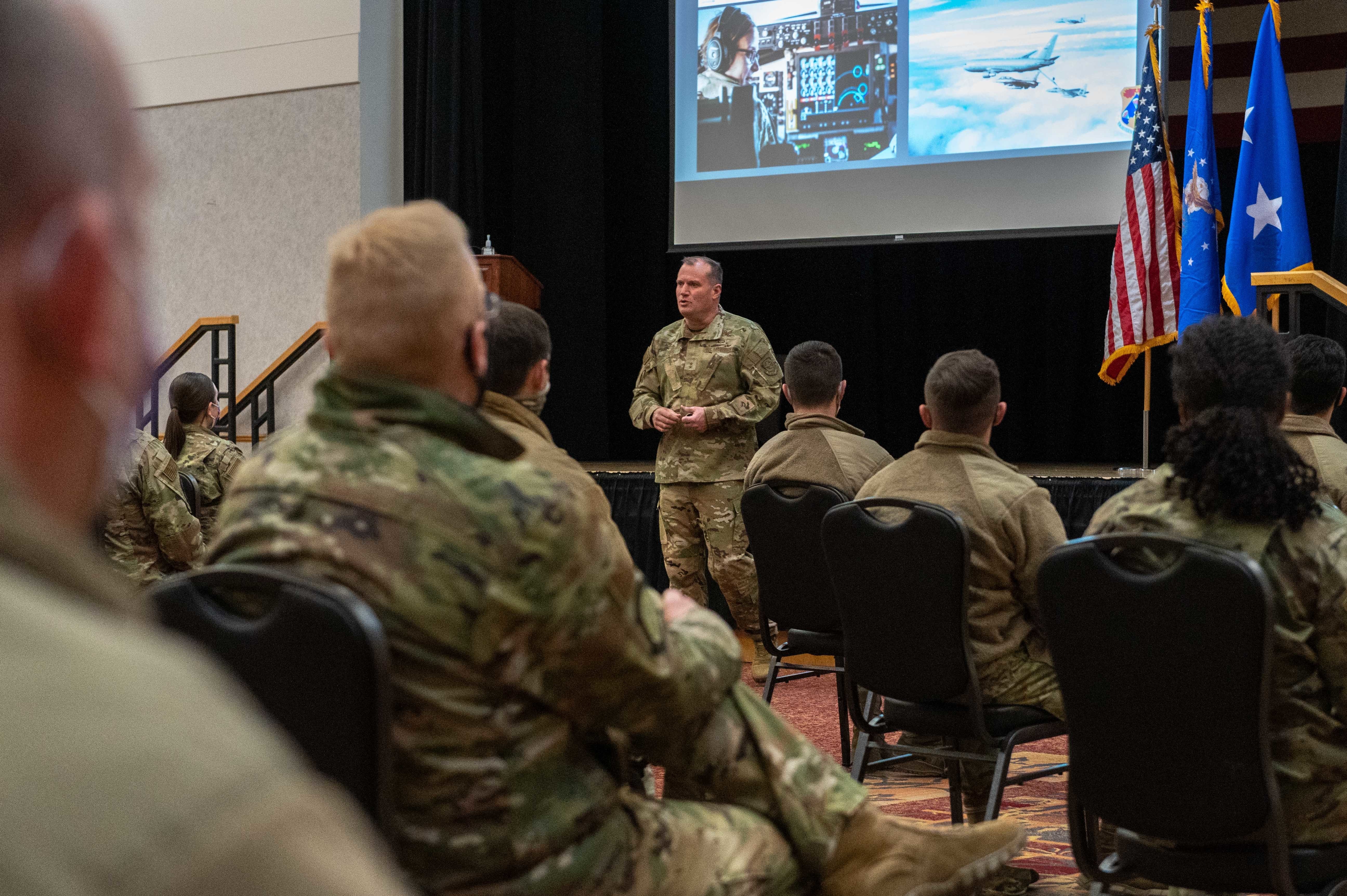Military Bases In Kansas - The US Air Force is working to increase the number of strategic bomber bases that can carry nuclear weapons from two today to five by the 2030s.
The plan would also significantly increase the number of bomber bases housing nuclear cruise missiles from one today to all five bomber bases by 2030.
Military Bases In Kansas
The expansion is the result of a decision to replace the non-nuclear B-1B bombers at Ellsworth AFB and Dyess AFB with nuclear B-21s over the next half decade and to restore nuclear weapons storage capacity at Barksdale AFB. as well as
Exposures And Military Bases In The United States
General Timothy Wray, commander of the Air Force Global Strike Command, told Congress last year that the expansion was not expected to increase the number of nuclear weapons assigned to the bomber force, but to expand the infrastructure "to accommodate the growth of the mission." to be done
The Air Force announced in May 2018 that the B-21 will replace the B-1B and B-2A bombers and will be stationed at Ellsworth AFB, Dyess AFB and Whiteman AFB. The Strategic Bomber Force commander later explained in a video address from the B-1B base that "the B-21 will bring significant changes at every point, including the reintegration of nuclear mission requirements."
Since the B-1B was replaced by the B-2A in the nuclear warhead program in 1997 and all B-1B bombers were decommissioned in 2011, the B-21 bomber program has the effect that all three bases of operation of the nuclear bomber will increase. . Five bases from today to the future (see map):
The Air Force plans to increase the storage capacity of nuclear weapons at the bomber base from two today to five in the future. Click on the map to view full size.
Where Housing Is Least And Most Affordable For Military Families
The Air Force previously planned for the B-21 to replace the B-2A by 2032 and the B-1B by 2036, though those dates may change.
The effect of the B-21 integration is that the nuclear stealth bomber base will increase from one today (Whitman AFB) to three in the future.
The modernization plan appears to expand the location of nuclear cruise missiles from one base today (Minot AFB) to all five bomber bases by the late 2030s. LRSO is scheduled to enter the arsenal in 2030 (see table):

The US Air Force plans to significantly expand its nuclear bomber base and capabilities. Click on the table to view full size.
Critical Air Force Base Flooded In Nebraska
A key element of upgrading the bases to operate the B-21 involved the construction of a new nuclear weapons storage facility at each base: the Weapons Generation Facility (WGF). The new facility differs from the Weapons Storage Area (WSA) built by the Air Force during the Cold War in that it will integrate a set of maintenance and storage missions into the same facility. The WGF footprint will cover approximately 35 acres and will include approximately 52,000 square feet (4,860 square meters) of building space as well as a 17,600 square foot ammunition maintenance building. The Air Force said the WGF would be "unique to the B-21 mission" and designed to provide a "safer and more secure location to store Air Force nuclear weapons."
A draft environmental impact statement recently published by the Air Force shows the planned locations of nuclear weapons storage facilities at Dyess and Ellsworth Air Force Bases. At Dyess AFB, the intention is to build a facility on the north end of the base near the existing ammunition depot (see map below):
The Air Force plans to increase nuclear weapons storage capacity at Davis Air Force Base in Texas. Click on the map to view full size.
At Ellsworth AFB, the Air Force has identified two priority locations: one near the ammunition depot on the north end, and one near the aircraft warning apron on the south end (see map below):
Deep Underground Military Bases
The Air Force plans to add nuclear weapons storage capacity at Ellsworth Air Force Base in South Dakota. Click on the map to view full size.
Although Barksdale AFB is not scheduled to receive B-21s, preparations are underway to restore a nuclear weapons storage capability to the base. That capability was eliminated when the Air Force consolidated operational nuclear ALCM storage at Minot AFB a decade ago. Once completed, the new WGF will allow the base to store nuclear LRSO cruise missiles for delivery by B-52s.
The B-21 bomber program is expected to increase the overall size of the US strategic bomber force. The Air Force currently operates about 158 bombers (62 B-1B, 20 B-2A, and 76 B-52H) and has long stated that it intends to purchase at least 100 B-21 bombers. . That number now appears to be at least 145, which would bring the bomber force from 62 to about 220. There are currently nine bomber squadrons. , the number of the Air Force wants to increase to 14 (each base has more than one squadron).

During an interview with reporters in April, AFGSC chief General Timothy Ray reportedly said that the 220 number was "a minimum, not a maximum" and added: "As an Air Force Now we believe it's more than 220." Whether Congress will agree to pay for so many B-21s remains to be seen.
Map Of Army Bases Where Dentists Can Serve
Fielding large numbers of nuclear-capable B-21 bombers has implications for the future development of US nuclear weapons. Under the New START treaty, the US has announced that it will not use more than 60 nuclear bombers. Although the agreement expires in 2026 (after a maximum extension of five years), it serves as a baseline for long-term nuclear energy structural planning.
Unless the Air Force limits the number of nuclear-armed B-21 bombers to the number of B-2As operating today, the number of nuclear-powered bombers will begin to exceed the commitment of 60 deployed nuclear bombers by 2028. (Assume a year of production of nine aircraft. And a two-year delay in deployment of the first nuclear unit). By 2035, the number of nuclear bombers in use could double from today (see graph below):
As long as the B-21 nuclear bomber is not limited, the power of future nuclear bombers could significantly exceed that of the bombers under the current New START treaty. Click on the graph to view full size.
Even without New START, it is difficult to imagine a military justification for such an increase in the number of nuclear bombers. One would hope that the number of nuclear B-21s would be limited to much less than the total number. While the New START treaty may have expired before it became a legal issue, it would now send the wrong message to other nuclear-armed nations about America's long-term intentions, skepticism and "great power rivalry." Could complicate future weapons. control negotiations.
Berry Garment Manufacturer's Inc., Columbus, Kansas
In the short term, the incoming Biden administration must commit the United States not to increase the number of nuclear bombers under the New START treaty, and it must urge Russia to reduce the size of its nuclear bomber force. Declare the same.
This publication is made possible by the generous support of the John D. and Catherine T. MacArthur Foundation, the Newland Foundation, the Plowshares Fund and the Prospect Hill Foundation. Statements and opinions presented are entirely the responsibility of the author. Share on Facebook Share on Twitter Share on LinkedIn Share on Reddit Share on Flipboard Share via Email Comment
First public map of more than 100 US military bases in 41 states with coronavirus cases Map by Bill Morris; Basic data according to natural soil
Like other countries, the U.S. military is fighting a growing coronavirus outbreak with cases at 41 bases. But military leaders also struggle to strike a balance between the competing needs for transparency and privacy.
Cnn Exclusive: Fbi Investigation Determined Chinese Made Huawei Equipment Could Disrupt Us Nuclear Arsenal Communications
According to Department of Defense data, 2,120 men and women in uniform have tested positive for the COVID-19 virus. The US Navy has the highest number of cases, followed by the Army, Air Force and Marine Corps. Civilians working for the department are the second largest group overall after those in uniform. The next most affected groups are military dependents and private contractors at military installations.
The Pentagon's secrecy about these numbers, intended to quell concerns about health and readiness, has fueled suspicion and sparked controversy.
President Donald Trump arrives to speak at the signing of the John S. McCain National Defense Authorization Act for Fiscal Year 2019 at Fort Drum, New York on August 13, 2018. BRENDAN SMIALOWSKI/AFP via Getty Images This article requires additional citations for verification. . Please help improve this article by adding references to reliable sources. Unsourced content may be challenged and removed. Find source: "McConnell Air Force Base" – News · Newspapers · Books · Scholars · JSTOR (November 2021) (Learn how and from whom to remove this template message)
37°37′23″N 097°16′02″W / 37.62306°N 97.26722°W / 37.62306; -97.26722 Coordinates: 37°37′23″N 097°16′02″W / 37.62306°N 97.26722°W / 37.62306; -97.26722
Military Housing In Belton, Mo
McConnell Air Force Base (IATA: IAB, ICAO: KIAB, FAA LID: IAB) is a United States Air Force base four miles (6 km) southeast of the Wichita corporate business district in Sedgwick County, Kansas, United States. located in . state
The air base was named in honor of Wichita brothers Fred and Thomas McConnell, both
Military bases kansas, military bases in georgia, military bases in missouri, military bases in maryland, military bases in minnesota, military bases in tennessee, military bases in washington, military bases in pennsylvania, military bases in massachusetts, military bases in arkansas, military bases in kansas city, military bases in colorado


0 Comments